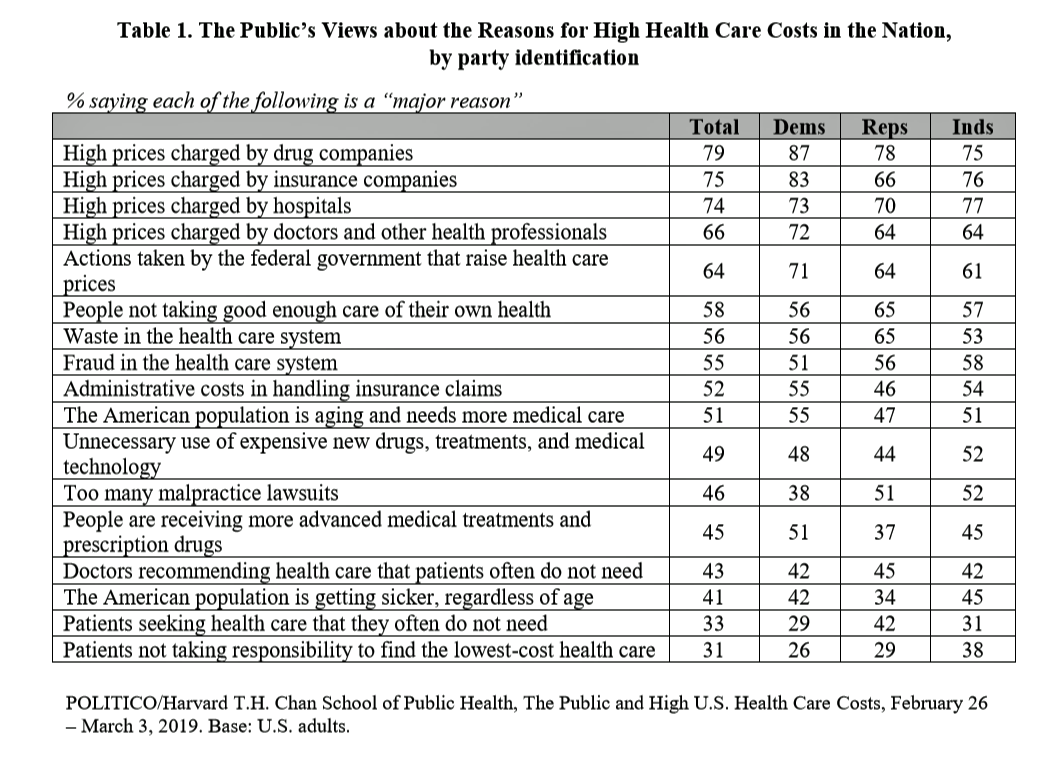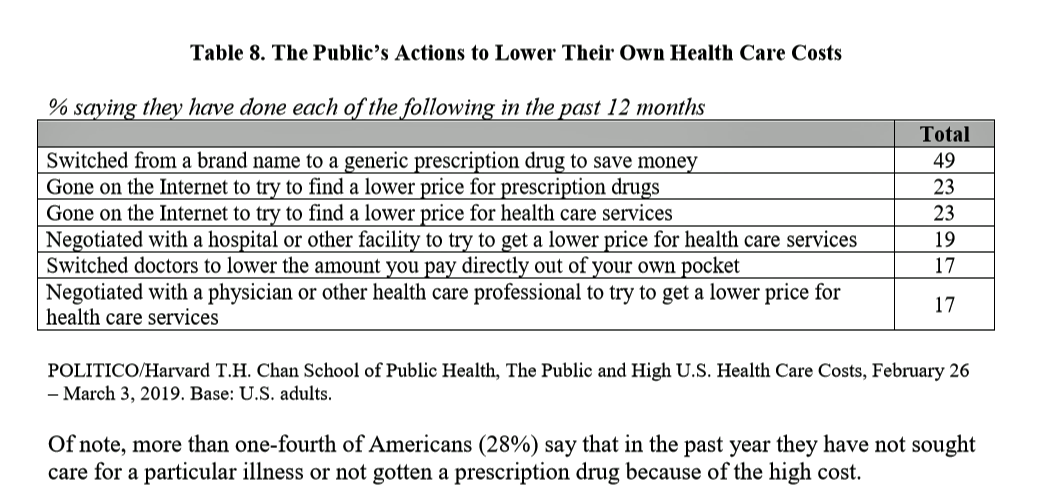There’s little agreement between Democrats and Republicans on a plethora of issues in American public life. But one issue that brings U.S. citizens together is agreement that the cost of health care is too high in the country, and that pharma, health plans, and providers are to blame.
 Welcome to health politics in America as of March 2019, according to The Public and High U.S. Health Care Costs, a poll conducted by POLITICO and the Harvard T.H. Chan School of Public Health.
Welcome to health politics in America as of March 2019, according to The Public and High U.S. Health Care Costs, a poll conducted by POLITICO and the Harvard T.H. Chan School of Public Health.
The first chart illustrates the common ground shared by Americans by party affiliation, with vast majorities across parties playing the blame game on healthcare industry groups.
Note that 58% overall believe another cost driver is people not taking good enough care of their own health, with 58% of Democrats, 65% of Republicans, and 57% of Independence blaming fellow citizens for lack of self-care. A similar percentage overall blames waste, fraud and administrative costs in the system for high health care spending in America.
Patients over-using care and not shopping around on the basis of price garner the lowest percentages of blame, with about 1 in 3 people ascribing blame to these factors.
One of the larger delta/differences on this list between Democrats and Republicans relates to people receiving more advanced medical treatments and prescription drugs: 51% of Democrats blame high costs on newer treatments, while only 37% of Republicans do so.
How can the U.S. reduce the high cost of health care? The most-agreed strategy would be to advance prevention of future disease and to ensure that people live healthier lives, cited by 84% of Americans, and fully 8 of 10 people across political party.
After this strategy, few solutions have this level of agreement across party divides. Most Republicans (74%) favor fostering greater competition between health care professionals and hospitals; 73% of Democrats point to the government capping prices on hospital and provider charges, allowing people 50-64 to buy into Medicare, and changing the health system so that most people have Medicare with little to no private insurance.

The most prevalent action individuals have taken to lower their own health care costs was to switch from a brand name to a generic prescription drug, done by 49% of Americans polled. Well below this cost-saving tactic were searching the Internet for lower prices for medicines, searching on the Internet to lower prices on health care services, negotiating with hospitals for lower prices, switching doctors to lower out of pocket costs, and negotiating with physicians for lower prices on services. The second chart details these health consumer strategies.
One in four U.S. consumers (28%) have not sought health care or filled a prescription drug due to the high cost — a cost-saving tactic done by 32% of Democrats, 24% of Republicans, and 25% of Independents.
Health Populi’s Hot Points: The broad consensus in America is that health care costs are too high, an opinion shared across political parties. And, most people in the U.S. told POLITICO and the Harvard team that prevention and health promotion embody the most important strategy for lowering health care costs in the nation. Competition and setting cost-limits were also majority-shared tactics across party affiliations.
 As for leveraging Medicare to cover more Americans as a cost-lowering strategy, health citizens are at-odds. Roughly one-half of people overall are concerned that Medicare will run out of money in the next decade. Americans are also split by party whether the Federal government versus State governments would be more effective at setting those health care prices.
As for leveraging Medicare to cover more Americans as a cost-lowering strategy, health citizens are at-odds. Roughly one-half of people overall are concerned that Medicare will run out of money in the next decade. Americans are also split by party whether the Federal government versus State governments would be more effective at setting those health care prices.
The researchers conclude that whichever party “dominates” the future leadership in the executive and legislative branches will determine the eventual approach to cost containment — Democrats would tend to seek greater government intervention, whereas Republicans would look for private insurance and competitive market forces.
The one major agreement is that prescription drug costs are too high, and generics are beloved by American health consumers looking for pills at a price.
It’s certain that health care will dominate discussions between “now” and November 7, 2020, when health care will certainly drive people — and women, especially driven by medical cost concerns — to the polls. Why do I say this? The third chart informs my forecast, illustrating that women in pre-retirement are more concerned about health care and long-term care costs more so than men are. LIMRA wrote up this analysis in honor of National Women’s History Month as it draws to a close this month of March 2019.
I predict that the history of the 2020 Presidential election in the U.S. will drive a plurality of cost-and-coverage concerned women to the polls as health care voters.
The post Most Americans Blame Drug Companies, Insurers, and Hospitals for High Health Care Costs appeared first on HealthPopuli.com.
Most Americans Blame Drug Companies, Insurers, and Hospitals for High Health Care Costs posted first on https://carilloncitydental.blogspot.com
Sort of Care offered: What is the way of thinking of care that a specific office offers? Is the accentuation on a strict mending, on bunch treatment, guiding, what precisely is the highlight on? Do you concur with the way of thinking of care? What are your convictions? Do they coordinate with the consideration advertised? Likewise discover what is the degree of one on one consideration offered by the office and parity this against the expense of the office to perceive what is beneficial by perceiving what number of individual meetings with a clinician are incorporated.
ReplyDeleteinspirational quotes for addiction
inspirational quotes for addicts
beating addiction quotes
motivational recovery quotes
This rehab thinks about the requirements of the family and includes them all through the rehabilitation, mending and recuperation process. The program tracks are explicitly intended to address the issues of Christian heavy drinkers and addicts. They as a rule have proficient staff and pastorate speaking to Lutheran, Redeemer Free, Catholic, Assembly of God, Methodist, and Southern Baptist categories. Ministers from different sections are additionally accessible if important. The patients are urged to ask and think about God's promise three times each day in the sanctuary. The principle thought is that the patient should feel that Jesus is strolling with them through treatment and giving them an uncommon perfect recuperating contact.
ReplyDeletealcohol rehab center florida